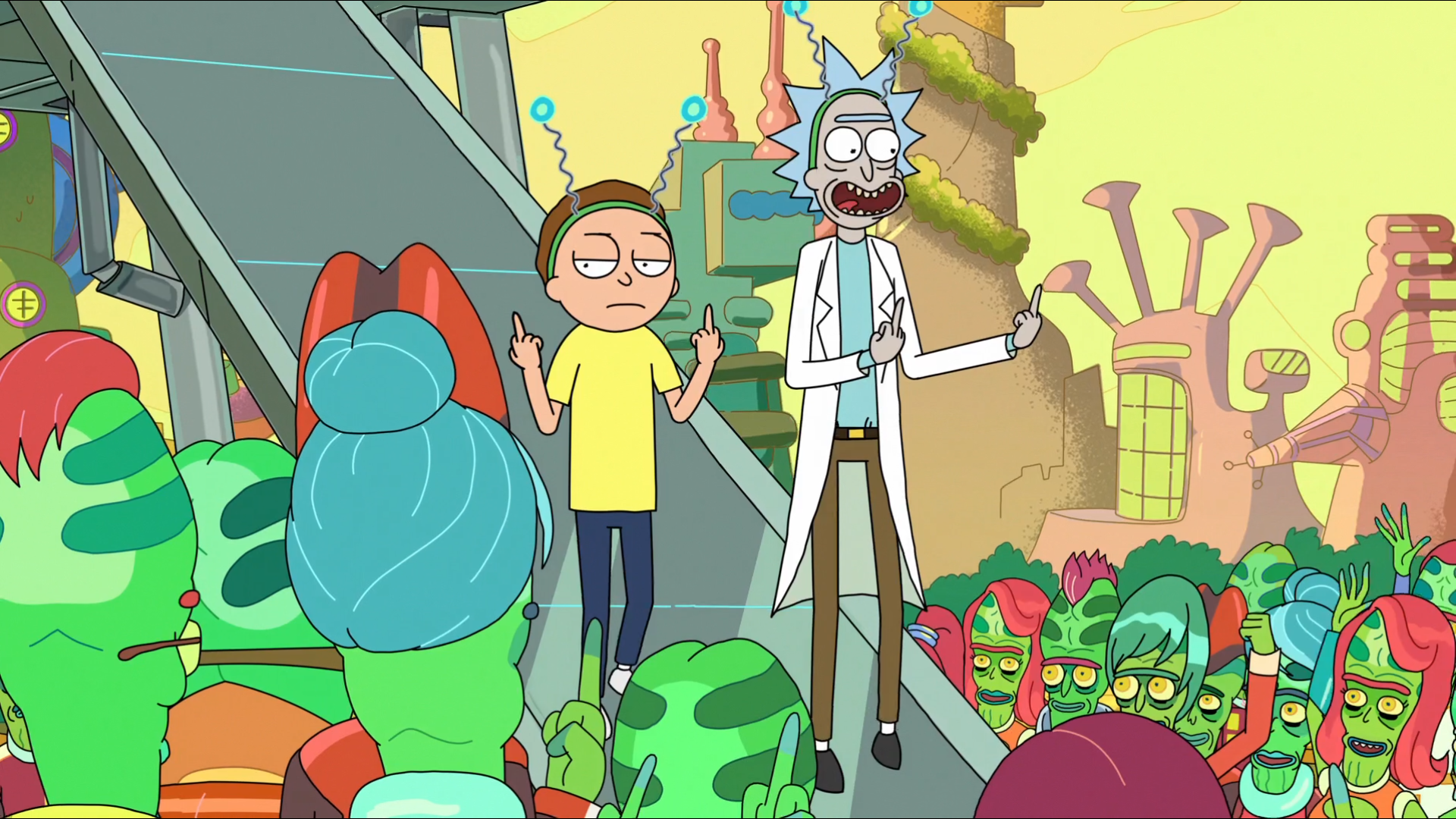Rick and Morty —an absurdist animated television series currently running on Cartoon Network— is the latest installment in a nearly-three decade popular television cycle heavily indebted to the concept of animated subversion, of which it marks the furthest extension but also the possible exhaustion. Originally airing on Cartoon Network’s Adult Swim programming block in 2013, Rick and Morty is concerned with the adventures of the depraved and hedonistic super-scientist Rick Sanchez and his gormless grandson Morty as they travel through the universe and alternate dimensions. Individual episodes range between narrative and comic styles, from extended parodies of popular culture to narrative games and referential engagement with genre conventions to bleakest black humour premised on emotional emptiness and nihilistic despair.
With its science-fiction premise, Rick and Morty resembles a darker and more unhinged version of Matt Groening’s Futurama spliced with the formal experimentation and play that mark the most baroque excesses of Family Guy. In such ways, Rick and Morty takes full advantage of its animated nature as the basis for spectacular set pieces, casually excessive violence, oddball characters and elaborate visual tricks and sight gags. These are all animated excesses that emphasize the artifice of the text and thereby hold out the possibility of potentially subverting accepted assumptions surrounding ideas of regulation, rationality, and potentially reality itself (Wells 1998: 11, 26; Wells 2003: 16). Indeed, even the pupils of the character’s eyes would seem to kick out against expectations when close inspection reveals that the clean edges of traditional dots have been replaced by uneven and unstable scribbles.
This would be an orthodox account of Rick and Morty following the influential and insightful work of Paul Wells regarding the politics of advertising. Wells’ account of the inherent political aesthetics of animation as form and the institutional challenges posed by primetime animation with shows such as The Flintstones and The Simpsons provides particularly productive resources for making sense of the prejudice and resistance historically arraigned against adult animation (Wells 2002: 94-5). When considered in light of the unreceptive cultural context that greeted those earlier works, animation certainly appears to enact a subversive salvo against the status quo. However, the politics of animation are not a matter of form alone, but rather are produced out of the interaction between form and context and, as such, Rick and Morty needs to be understood in light of new cultural institutions and norms. It is now over 27 years since The Simpsons first aired, and 26 since Ren and Stimpy originally appeared. Animated primetime is no longer an aberration, but rather an expectation (for those still attentive to the politics of scheduling): ‘cartoons for grown-ups’ are no longer a novelty, but a self-contained history of failures, successes, auteurs and masterpieces familiar to fans of the genre. The social conditions of animation have changed accordingly. The result is not that animation is seen as serious (such an outcome seems as far away as ever), but rather that it appears as an expected and permitted site of subversion, as a socially sanctioned site of not just formal but also social and cultural experimentation. This cultural moment is what makes possible the aesthetic and obscene excesses of a show like Rick and Morty, but also contains by them: a dialectic that limits the political consequences of commercial animation even as it enables their conception. Conceived in this manner —as the culmination of a long running political aesthetic trend—, Rick and Morty appears as a testament to the experimentation and anarchy emic to animation aesthetics, but also an indication of popular animation’s increasing political (self)containment.
References
Wells, P (1998), Understanding Animation. London: Routledge.
Wells, P (2000), Animation and America. Edinburgh: Edinburgh University Press.
Wells, P (2003) “‘Smarter than the Average Art Form’: Animation in the Television Era,” in Carol A. Stabile and Mark Harrison (eds.), Primetime Animation. London: Routledge, pp. 15–32.
Nicholas Holm is a Lecturer in Media Studies at Massey University, Palmerston North, where he teaches courses in advertising, popular culture, humour and the media and introductory media studies. His research addresses the politics of everyday life and popular culture with particular focus upon the politics of humour. He is the author of Humour as Politics (Palgrave 2017) and Advertising and Consumer Society (Palgrave 2017) and the co-editor of Ecological Entanglement in the Anthropocene (Lexington 2017).



I love this post, especially how it highlights that animation “for adults” is still largely humour-based and anarchic, usually avoiding a serious tone. This extends to much of [adult swim]’s animated line up, making cartoons that aren’t for kids, but aren’t necessarily seen as “grown up” either.